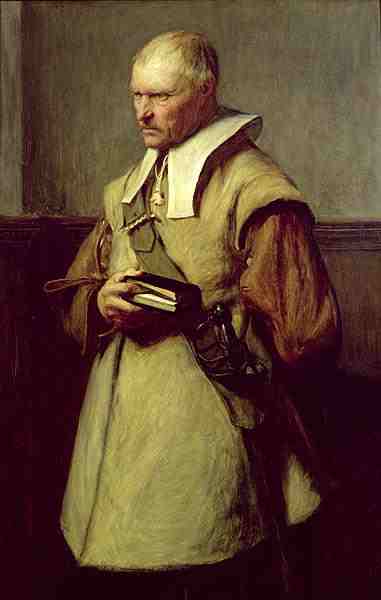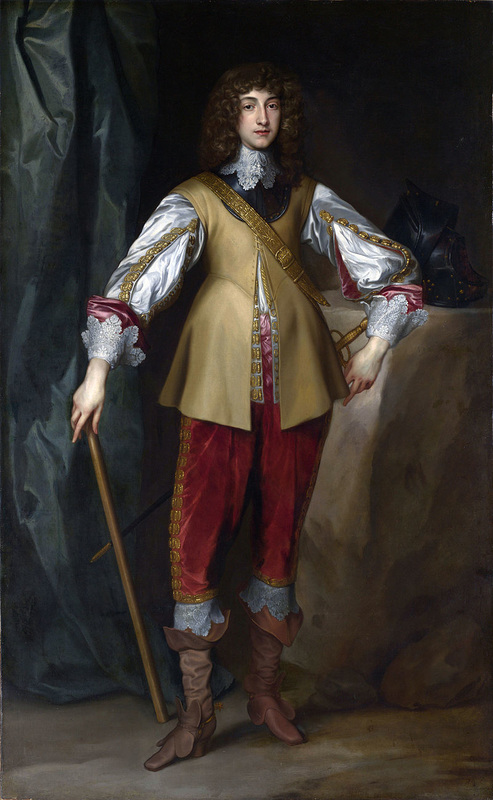Box People in the Time of Civil War
David Ibberson
April 2016
David Ibberson
April 2016
Introduction
To us living in the 21st century it is impossible to picture what life was like in the latter half of the 17th century. Suffice it to say,
it was harsh, brutal and sometimes violent, made far worse by the English Civil Wars of 1642 to 1651 when Parliamentarians (sometimes called Roundheads) were in open conflict with the Royalists (Cavaliers).
If life was harsh, the war years made it a whole lot worse when soldiers were billeted with villagers. The soldiers had to be fed and they weren't shy of helping themselves to whatever the household had to offer. Add to this, increasing taxation as the war progressed, and many households were thrown into dire poverty. Both Roundheads and Cavaliers would have been a familiar sight to those living in Box and were a constant threat.
Around Box major battles were being fought at Lansdown on 5 July 1643, Roundway Down, Devizes, on 13 July 1643 and in Chippenham on 20 March 1643 and again on 8, 9 and 17 July 1643, and later in 1645 on 15 February, 9 May and 12 July. On 26 September 1645 the Roundheads took Lacock from the Royalists, diminishing Royalist influence in this part of Wiltshire.
To us living in the 21st century it is impossible to picture what life was like in the latter half of the 17th century. Suffice it to say,
it was harsh, brutal and sometimes violent, made far worse by the English Civil Wars of 1642 to 1651 when Parliamentarians (sometimes called Roundheads) were in open conflict with the Royalists (Cavaliers).
If life was harsh, the war years made it a whole lot worse when soldiers were billeted with villagers. The soldiers had to be fed and they weren't shy of helping themselves to whatever the household had to offer. Add to this, increasing taxation as the war progressed, and many households were thrown into dire poverty. Both Roundheads and Cavaliers would have been a familiar sight to those living in Box and were a constant threat.
Around Box major battles were being fought at Lansdown on 5 July 1643, Roundway Down, Devizes, on 13 July 1643 and in Chippenham on 20 March 1643 and again on 8, 9 and 17 July 1643, and later in 1645 on 15 February, 9 May and 12 July. On 26 September 1645 the Roundheads took Lacock from the Royalists, diminishing Royalist influence in this part of Wiltshire.
|
Why did so many conflicts take place in the area? Many large houses were used as garrisons and were frequently the setting for a siege: Great Chalfield and Farleigh Castle being two examples. Local battles were also due to the importance of Malmesbury, an important town on the Royalist supply route, situated as it is between Bristol and Oxford (where King Charles had raised his standard at the beginning of the war).
Wiltshire, Gloucestershire and Somerset were important areas for providing food, clothing and munitions to both sides. During the war, Malmesbury changed hands five times between 1642 and 1645 before becoming a permanent Roundhead garrison. Should you doubt the brutality of this war, then visit Malmesbury Abbey where, on the west side, you will find shot marks at a site where prisoners were executed. Place in the mix, the religious commitment that fuelled both sides with Royalists accused of Catholic leanings and Roundheads of being Puritans. The war pitted brother against brother, father against son, and neighbour against neighbour. Around then, powerful families were also divided. The Spekes of Hazelbury and the Longs were Royalist, the Hungerfords of Corsham and Farleigh Castle were Parliamentarians. Right: Roundhead by John Pettie (courtesy Wikimedia Common) |
A Fallen Priest
This was the setting into which Walter Bushnell was appointed vicar of Box in 1644. Right up to the 1900s vicars were appointed through the advowsen system, whereby an individual owned the right to recommend, to the bishop, a clergyman of their choosing to a vacant ministry. The last time that the Box advowsen was sold it was purchased by William Stincomb of Pottern, the father-in-law of the Rev George Gardiner for the sum of £4,500, a considerable sum in 1874.
The appointment of Walter Bushnell was almost certainly influenced by George Speke who owned the Box advowsen up to the Civil War. It can be assumed that Walter was on side with George Speke's wishes, unlikely to stir up villagers that worked on the Speke estate. However, five years after the war ended, Walter found himself accused of being an Ignorant and Insufficient minister and appearing before a Committee of Ejectors. These committees were established to remove from their livings priests considered unsuitable, that is, not adhering to strict puritan doctrines as prescribed by the church.
This was the setting into which Walter Bushnell was appointed vicar of Box in 1644. Right up to the 1900s vicars were appointed through the advowsen system, whereby an individual owned the right to recommend, to the bishop, a clergyman of their choosing to a vacant ministry. The last time that the Box advowsen was sold it was purchased by William Stincomb of Pottern, the father-in-law of the Rev George Gardiner for the sum of £4,500, a considerable sum in 1874.
The appointment of Walter Bushnell was almost certainly influenced by George Speke who owned the Box advowsen up to the Civil War. It can be assumed that Walter was on side with George Speke's wishes, unlikely to stir up villagers that worked on the Speke estate. However, five years after the war ended, Walter found himself accused of being an Ignorant and Insufficient minister and appearing before a Committee of Ejectors. These committees were established to remove from their livings priests considered unsuitable, that is, not adhering to strict puritan doctrines as prescribed by the church.
|
Walter vigorously defended his position and, fortunately for history, he recorded a narrative of his trial. Putting aside the legal and theological arguments, he introduced us to a range of characters living in Box and district at that time.
Not surprisingly, he had nothing good to say about them since they all offered evidence against him: Obediah Cheltenham of Ditteridge, a clothier; the Pinchins, William, his wife, Elizabeth, and his mother, Joan, all of Box Mill; the Cottles, William and Richard, of Box, and Lawrence of Ditteridge; John Twyford, the local hangman; William Sanders of Chippenham, whose father lived at Church House. Walter commented that most of the people mentioned had committed offenses for which the law prescribed pillory, ear removal, nose splitting or branding. Walter blamed Capt John Travers of Slaughterford for getting these witnesses together. Travers was a rogue, burglary being his main occupation. Perhaps uncharitably, Walter expressed some satisfaction when Travers died a beggar shortly after the trial ended. Walter did have supporters although he did not list them. He had a defence counsel, Colonel Eyres, the local Justice of the Peace. It is difficult to be certain who this person was. In 1631 Great Chalfield was sold by Sir John Eyre but he did retain a life interest in the estate for his mother, Dame Ann. She was resident when it was a Roundhead garrison in 1644 under siege by the Royalists. Another reference records a Lieut-Col Eyres captured by Royalists during the battle of Chippenham on 12 July 1645. |
The Legacy
The outcome of the trial was that Walter was removed from his living in Box. Written in legend in Box and surrounding area are stories arising from the Civil War period. Sheldon Manor, near Allington, is said to be haunted by Roundhead Cavalry galloping past the house on the way to Chippenham. In the parish of Bathford, near Brown's Folly, is an interesting story about Sally in the Woods. There are several stories attached to this name, one of which relates to the Civil War. It seems that the word Sally was used at the time to mean a sudden rush from a place besieged by the enemy. Just before the Battle of Lansdown, Royalists ambushed some Roundheads at the spot we know as Sally in the Woods.
Cheney Court, Ditteridge, was owned at the time by the Spekes of Hazelbury. In the 1980s, when Cheney Court was a hotel and restaurant, the promotional literature boasted that Queen Henrietta Maria, wife of Charles I, remained hidden there until she escaped to France.
Reflections
In reading this article we should spare a thought for the people of Syria who find themselves attempting to live in a country torn apart by Civil War. We should be grateful that weaponry available to our Cavaliers and Roundhead ancestors did not have the destructive power of 21st century warfare.
Sources
David Ibberson, The Vicars of St Thomas à Becket, 1987
Wiltshire and Swindon History Centre
Malmesbury - http://www.malmesbury.com
The outcome of the trial was that Walter was removed from his living in Box. Written in legend in Box and surrounding area are stories arising from the Civil War period. Sheldon Manor, near Allington, is said to be haunted by Roundhead Cavalry galloping past the house on the way to Chippenham. In the parish of Bathford, near Brown's Folly, is an interesting story about Sally in the Woods. There are several stories attached to this name, one of which relates to the Civil War. It seems that the word Sally was used at the time to mean a sudden rush from a place besieged by the enemy. Just before the Battle of Lansdown, Royalists ambushed some Roundheads at the spot we know as Sally in the Woods.
Cheney Court, Ditteridge, was owned at the time by the Spekes of Hazelbury. In the 1980s, when Cheney Court was a hotel and restaurant, the promotional literature boasted that Queen Henrietta Maria, wife of Charles I, remained hidden there until she escaped to France.
Reflections
In reading this article we should spare a thought for the people of Syria who find themselves attempting to live in a country torn apart by Civil War. We should be grateful that weaponry available to our Cavaliers and Roundhead ancestors did not have the destructive power of 21st century warfare.
Sources
David Ibberson, The Vicars of St Thomas à Becket, 1987
Wiltshire and Swindon History Centre
Malmesbury - http://www.malmesbury.com

